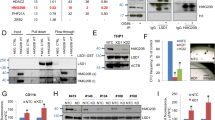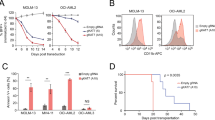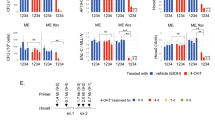Abstract
MEL1 (MDS1/EVI1-like gene 1/PRDM16), which was identified as a gene near the chromosomal breakpoint in t(1;3)(p36;q21)-positive human acute myeloid leukemia cells, belongs to the PRDI-BF1-RIZ1 homologous (PR) domain (PRDM) family of transcription repressors. The short form of MEL1 (MEL1S), which lacks the PR-domain at the N-terminus, is the main form expressed in t(1;3)(p36;q21)-positive acute myeloid leukemia cells. The overexpression of MEL1S blocks granulocyte colony-stimulating factor (G-CSF)-induced myeloid differentiation in interleukin-3-dependent murine myeloid L-G3 cells. In this study, we show that treatment with the histone deacetylase inhibitor trichostatin A abolished the blockade of myeloid differentiation in L-G3 cells overexpressing MEL1S. The expression of MEL1S containing mutated CtBP-interacting motif (CIM) in L-G3 cells still blocked the myeloid differentiation induced by G-CSF. We found that the small ubiquitin-related modifier (SUMO) motif (SM) at lysine 568 (VKAE) adjacent to the CIM was necessary to obtain the maximum transcriptional repressor activity of MEL1S. L-G3 cells expressing MEL1S, and bearing mutated CIM and SM differentiated into granulocytes in response to G-CSF; this indicated that both the SUMO modification at lysine 568 and CtBP binding were required for MEL1S-mediated transcriptional repression and blockade of differentiation, which might be relevant for the process of leukemogenesis.
This is a preview of subscription content, access via your institution
Access options
Subscribe to this journal
Receive 50 print issues and online access
$259.00 per year
only $5.18 per issue
Buy this article
- Purchase on Springer Link
- Instant access to full article PDF
Prices may be subject to local taxes which are calculated during checkout









Similar content being viewed by others
References
Bloomfield CD, Garson OM, Volin L, Knuutila S, de la Chapelle A . (1985). t(1;3)(p36;q21) in acute nonlymphocytic leukemia: a new cytogenic-clinicopathologic association. Blood 66: 1409–1413.
Chinnadurai G . (2007). Transcriptional regulation by C-terminal binding proteins. Int J Biochem Cell Biol 39: 1593–1607.
DuBridge RB, Tang P, Hsia HC, Phai-Mooi L, Miller JH, Calos MP . (1987). Analysis of mutation in human cells by using Epstein-Barr virus shuttle system. Mol Cell Biol 7: 379–387.
Friedman AD, Krieder BL, Venturelli D, Rovera G . (1991). Transcriptional regulation of two myeloid-specific genes, myeloperoxidase and lactoferrin, during differentiation of the murine cell line 32Dcl3. Blood 78: 2426–2432.
Giorgino F, de Robertis O, Laviola L, Montrone C, Perrini S, McCowen K et al. (2000). The sentrin-conjugating enzyme mUBC9 interacts with transient transfection GLUT4 and GLUT1 glucose transporters and regulates transporter levels in skeletal muscle cells. Proc Natl Acad Sci USA 97: 1125–1130.
Gluzman Y . (1981). SV40-transformed simian cells support the replication of early SV40 mutants. Cell 23: 175–182.
Greenberger JS, Sakakeeny MA, Humphries RK, Eaves CJ, Eckner RJ . (1983). Demonstration of permanent factor-dependent multipotential (erythroid/neutrophil/basophil) hematopoietic progenitor cell line. Proc Natl Acad Sci USA 80: 2931–2935.
Izutsu K, Kurokawa M, Imai Y, Maki K, Mitani K, Hirai H . (2001). The corepressor CtBP interacts with Evi-1 to repress transforming growth factor beta signaling. Blood 97: 2815–2822.
Kagey MH, Melhuish TA, Wotton D . (2003). The polycomb protein Pc2 is a SUMO E3. Cell 113: 127–137.
Kajimura S, Seale P, Kubota K, Lunsford E, Frangioni JV, Gygi SP et al. (2009). Initiation of myoblast to brown fat switch by a PRDM16-C/EBP-b transcriptional complex. Nature 460: 1154–1159.
Kajimura S, Seale P, Tomaru T, Erdjument-Bromage H, Cooper MP, Ruas JL et al. (2008). Regulation of the brown and white fat gene programs through a PRDM16/CtBP transcriptional complex. Genes Dev 22: 1397–1409.
Kinashi T, Lee HL, Ogawa M, Tohyama K, Tashiro K, Fukunaga R et al. (1991). Premature expression of the macrophage colony-stimulating factor receptor on a multipotential stem cell line does not alter differentiation lineages controlled by stromal cells used for coculture. J Exp Med 173: 1267–1279.
Kuppuswamy M, Vijayalingam S, Zhao LJ, Zhou Y, Subramanian T, Ryerse J et al. (2008). Role of the PLDLS-binding cleft region of CtBP1 in recruitment of core and auxiliary components of the corepressor complex. Mol Cell Biol 28: 269–281.
Long J, Zuo D, Park M . (2005). Pc2-mediated SUMOylation of Smad-interacting protein 1 attenuates transcriptional repression of E-cadherin. J Biol Chem 280: 35477–35489.
Maki K, Yamagata T, Mitani K . (2008). Role of the RUNX1-EVI1 fusion gene in leukemogenesis. Cancer Sci 99: 1878–1883.
Migliaccio G, Migliaccio AR, Kreider BL, Rovera G, Adamson JW . (1989). Transcriptional regulation of two myeloid-specific genes, myeloperoxidase and lactoferrin, during differentiation of the murine cell line 32D C13. J Cell Biol 109: 833–841.
Mitani K . (2004). Molecular mechanisms of leukemogenesis by AML1/EVI-1. Oncogene 23: 4263–4269.
Mochizuki N, Shimizu S, Nagasawa T, Tanaka H, Taniwaki M, Yokota J et al. (2000). A novel gene, MEL1, mapped to 1p36.3 is highly homologous to the MDS1/EVI1 gene and is transcriptionally activated in t(1;3)(p36;q21)-positive leukemia cells. Blood 96: 3209–3214.
Moir DJ, Jones PAE, Pearson J, Ducan JR, Cook P, Buckle VJ . (1984). A new translocation, t(1;3)(p36;q21), in myelodysplastic disorders. Blood 64: 553–555.
Morishita K . (2007). Leukemogenesis of the EVI1/MEL1 gene family. Int J Hematol 85: 279–286.
Morita Y, Kanei-Ishii C, Nomura T, Ishii S . (2005). TRAF7 sequesters c-Myb to the cytoplasm by stimulating its SUMOylation. Mol Biol Cell 16: 5433–5444.
Nishikata I, Sasaki H, Iga M, Tateno Y, Imayoshi S, Asou N et al. (2003). A novel EVI1 gene family, MEL1, lacking a PR domain (MEL1S) is expressed mainly in t(1;3)(p36;q21)-positive AML and blocks G-CSF-induced myeloid differentiation. Blood 102: 3323–3332.
Pear WS, Nolan GP, Scott ML, Baltimore D . (1993). Production of high-titer helper-free retroviruses by transient transfection. Proc Natl Acad Sci USA 90: 8392–8396.
Perdomo J, Verger A, Turner J, Crossley M . (2005). Role for SUMO modification in facilitating transcriptional repression by BKLF. Mol Cell Biol 25: 1549–1559.
Quinlan KGR, Nardini M, Verger A, Francescato P, Yaswen P, Corda D et al. (2006). Specific recognition of ZNF217 and other zinc finger proteins at a surface groove of C-terminal binding proteins. Mol Cell Biol 26: 8159–8172.
Rodriguez MS, Dargemont C, Hay RT . (2001). SUMO-1 conjugation in vivo requires both a consensus modification motif and nuclear targeting. J Biol Chem 276: 12654–12659.
Schaeper U, Boyd JM, Verma S, Uhlmann E, Subramanian T, Chinnadurai G . (1995). Molecular cloning and characterization of a cellular phosphorprotein that interacts with a conserved C-terminal domain of adenovirus E1A involved in negative modulation of oncogenic transformation. Proc Natl Acad Sci USA 92: 10467–10471.
Seale P, Bjok B, Yang W, Kajimura S, Chin S, Kuang S et al. (2008). PRDM16 controls a brown fat/skeletal muscle switch. Nature 454: 961–967.
Shimahara A, Yamakawa N, Nishikata I, Morishita K . (2010). Acetylation of lysine 564 Adjacent to the C-terminal binding protein-binding motif in EVI1 is crucial for transcriptional activation of GATA2. J Biol Chem 285: 16967–16977.
Shimizu S, Suzukawa K, Kodera T, Nagasawa T, Abe T, Taniwaki M et al. (2000). Identification of breakpoint cluster regions at 1p36.3 and 3q21 in hematologic malignancies with t(1;3)(p36;q21). Genes Chromosomes Cancer 27: 229–238.
Tillmanns S, Otto C, Jaffray E, Roure CD, Bakri Y, Vanhille L et al. (2007). SUMO modification regulates MafB-driven macrophage differentiation by enabling Myb-dependent transcriptional repression. Mol Cell Biol 27: 5554–5564.
Turner J, Crossley M . (1998). Cloning and characterization of mCtBP2, a co-repressor that associates with basic Krüppel-like factor and other mammalian transcriptional regulators. EMBO J 17: 5129–5140.
Welborn JL, Lewis JP, Jenks H, Walling P . (1987). Diagnostic and prognostic signification of t(1;3)(p36;q21) in the disorders of hematopoiesis. Cancer Genet Cytogenet 28: 277–285.
Acknowledgements
This work was supported in part by Grants-in-Aid for Scientific Research of Priority Area from the Ministry of Education, Culture, Sports, Science and Technology in Japan.
Author information
Authors and Affiliations
Corresponding author
Ethics declarations
Competing interests
The authors declare no conflict of interest.
Additional information
Supplementary Information accompanies the paper on the Oncogene website
Supplementary information
Rights and permissions
About this article
Cite this article
Nishikata, I., Nakahata, S., Saito, Y. et al. Sumoylation of MEL1S at lysine 568 and its interaction with CtBP facilitates its repressor activity and the blockade of G-CSF-induced myeloid differentiation. Oncogene 30, 4194–4207 (2011). https://doi.org/10.1038/onc.2011.132
Received:
Revised:
Accepted:
Published:
Issue Date:
DOI: https://doi.org/10.1038/onc.2011.132
Keywords
This article is cited by
-
Zebrafish prdm12b acts independently of nkx6.1 repression to promote eng1b expression in the neural tube p1 domain
Neural Development (2019)
-
PRDM16 functions as a suppressor of lung adenocarcinoma metastasis
Journal of Experimental & Clinical Cancer Research (2019)
-
SUMOylation of sPRDM16 promotes the progression of acute myeloid leukemia
BMC Cancer (2015)
-
An emerging role for prdm family genes in dorsoventral patterning of the vertebrate nervous system
Neural Development (2015)



